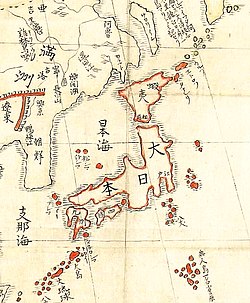Kōhei
Appearance
| Part of a series on the |
| History of Japan |
|---|
 |
Kōhei (康平) was a Japanese era (年号,, nengō,, lit. "year name") after Tengi and before Jiryaku. This period spanned the years from August 1058 through August 1065.[1] The reigning emperor was Go-Reizei-tennō (後冷泉天皇).[2]
Change of Era
- 1058 Kōhei gannen (康平元年) : The new era name was created to mark an event or series of events. The previous era ended and the new one commenced in Tengi 6, on the 29th day of the 8th month of 1058.[3]
Events of the Kōhei Era
- 1060 (Kōhei 3, 27th day of the 11th month): A broom star was observed in the south for seven nights.[4]
Notes
- ^ Nussbaum, Louis-Frédéric. (2005). "Kōhei" in Japan Encyclopedia, p. 543, p. 543, at Google Books; n.b., Louis-Frédéric is pseudonym of Louis-Frédéric Nussbaum, see Deutsche Nationalbibliothek Authority File.
- ^ Titsingh, Isaac. (1834). Annales des empereurs du japon, pp. 162-166; Brown, Delmer et al. (1979). Gukanshō, pp. 311-314; ; Varley, H. Paul. (1980). Jinnō Shōtōki. p. 197-198.
- ^ Brown, p. 313.
- ^ Pankenier, David et al. (2008). Archaeoastronomy in East Asia: Historical Observational Records of Comets and Meteor Showers from China, Japan, and Korea, p. 123., p. 123, at Google Books
References
- Brown, Delmer M. and Ichirō Ishida, eds. (1979). Gukanshō: The Future and the Past. Berkeley: University of California Press. 10-ISBN 0-520-03460-0; 13-ISBN 978-0-520-03460-0; OCLC 251325323
- Nussbaum, Louis-Frédéric and Käthe Roth. (2005). Japan encyclopedia. Cambridge: Harvard University Press. 10-ISBN 0-674-01753-6; 13-ISBN 978-0-674-01753-5; OCLC 58053128
- Pankenier, David W., Zhentao Xu and Yaotiao Jiang. (2008). Archaeoastronomy in East Asia: Historical Observational Records of Comets and Meteor Showers from China, Japan, and Korea. Amherst, New York: Cambria Press. 13-ISBN 9781604975871/10-ISBN 1604975873; OCLC 269455845
- Titsingh, Isaac. (1834). Nihon Odai Ichiran; ou, Annales des empereurs du Japon. Paris: Royal Asiatic Society, Oriental Translation Fund of Great Britain and Ireland. OCLC 5850691
- Varley, H. Paul. (1980). A Chronicle of Gods and Sovereigns: Jinnō Shōtōki of Kitabatake Chikafusa. New York: Columbia University Press. 10-ISBN 0231049404/13-ISBN 9780231049405; OCLC 6042764
External links
- National Diet Library, "The Japanese Calendar" -- historical overview plus illustrative images from library's collection
| Kohei | 1st | 2nd | 3rd | 4th | 5th | 6th | 7th | 8th |
| Gregorian | 1058 | 1059 | 1060 | 1061 | 1062 | 1063 | 1064 | 1065 |
|
Preceded by: |
Era or nengō: |
Succeeded by: |
